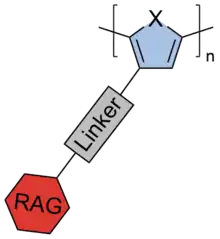Conducting redox polymers (CRPs) or intrinsically conducting redox polymers are organic polymers that combine the properties of conducting polymers and redox active polymers. They consist of a conducting polymer backbone with redox active pendant groups.[1]
The conducting backbone is usually polythiophene or polypyrrole based. As pendant groups quinones, radicals (eg. TEMPO), and metal complexes (eg. ferrocene) have been used.[2]

The conducting polymer backbone makes the addition of conductive additives obsolete which is a major advantage for practical applications like energy storage compared to conventional redox active polymers.[2]
Synthesis
The general strategy for the synthesis of conducting redox polymers is to attach a redox active group to a monomer (or a trimer) of the respective conducting polymer. These monomers, which are often EDOT derivatives, are subsequently polymerised either by electropolymerization or by chemical oxidative polymerisation (eg. with FeCl3 or Fe(OTs)3).[3]
Redox Potential Matching
When designing a conducting redox polymer it is important to consider the different redox-potentials of the pendant group and the polymer backbone, as the polymer backbone is only conductive in its doped state. If the polymer backbone loses its conductivity before the redox reaction of the pendant group is complete, the pendant group can get trapped in its charged state. In order to avoid charge trapping,[4] the polymer backbone must be sufficiently conductive in the potential region in which the redox-reaction of the pendant group occurs, hence the doping onset potential has to be lower than the redox-potential of the oxidation, or higher than the redox-potential of the reduction. Conducting redox polymers in which this is fulfilled, are referred to as having a potential match between the polymer backbone and the pendant group.[5][6]
References
- ↑ Karlsson, Christoffer; Huang, Hao; Strømme, Maria; Gogoll, Adolf; Sjödin, Martin (2014-10-16). "Probing Polymer–Pendant Interactions in the Conducting Redox Polymer Poly(pyrrol-3-ylhydroquinone)". The Journal of Physical Chemistry C. 118 (41): 23499–23508. doi:10.1021/jp506821z. ISSN 1932-7447.
- 1 2 Kondratiev, Veniamin V.; Holze, Rudolf (2021-02-13). "Intrinsically conducting polymers and their combinations with redox-active molecules for rechargeable battery electrodes: an update". Chemical Papers. doi:10.1007/s11696-021-01529-7. ISSN 1336-9075.
- ↑ PEDOT : principles and applications of an intrinsically conductive polymer. Andreas Elschner. Boca Raton, FL: CRC Press. 2011. ISBN 978-1-4200-6911-2. OCLC 166358478.
{{cite book}}: CS1 maint: others (link) - ↑ Zotti, G.; Schiavon, G.; Zecchin, S. (June 1995). "Irreversible processes in the electrochemical reduction of polythiophenes. Chemical modifications of the polymer and charge-trapping phenomena". Synthetic Metals. 72 (3): 275–281. doi:10.1016/0379-6779(95)03280-0.
- ↑ Yang, Li; Huang, Xiao; Gogoll, Adolf; Strømme, Maria; Sjödin, Martin (2015-08-20). "Matching Diethyl Terephthalate with n-Doped Conducting Polymers". The Journal of Physical Chemistry C. 119 (33): 18956–18963. doi:10.1021/acs.jpcc.5b05067. ISSN 1932-7447.
- ↑ Wang, Huan; Emanuelsson, Rikard; Liu, Haidong; Edström, Kristina; Mamedov, Fikret; Strømme, Maria; Sjödin, Martin (2019-10-28). "Redox-State-Dependent Interplay between Pendant Group and Conducting Polymer Backbone in Quinone-Based Conducting Redox Polymers for Lithium Ion Batteries". ACS Applied Energy Materials. 2 (10): 7162–7170. doi:10.1021/acsaem.9b01130. ISSN 2574-0962.